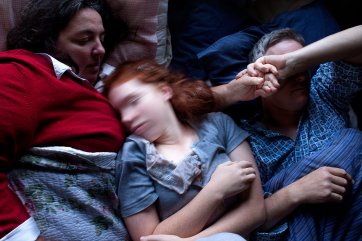How do you define your practice?
I am an aspiring photojournalist.
Do you have a website or are you represented on a website?
No
How would you describe your relationship to the subject/s?
Intimate. The subjects are my immediate family my mother, my sister and my father.
Was the photograph a result of a constructed, fabricated or candid encounter? Please describe.
Candid. I think the most important thing in capturing candid shots is to never take the photo when people are expecting you to press the shutter. The more poignant moments are not the stock standard images of people looking at the camera smiling but after or before when they are really interacting with each other. In the case of this photograph my family are so used to me taking pictures of them they don't take much notice of me anymore. I saw them all in bed on a Sunday afternoon and quickly got my camera. I think it is important to always be looking and observing no matter if you have a camera or not but always to be thinking about images and observing moments.
What are the ideas or themes underpinning your portrait?
I think the main issue is the fragility of life. I think this experience in my own life really made me realise what is important. It's not camera equipment or even materialistic things that add to my contentment. The relationships I have with my family and the people whom I love are so vital to my happiness. A small lump can have the potential to really change someone's life and it doesn't just affect them but all of the people that love them. I think the main thing is not to take people for granted because the line between life and death is fine and even the line between health and illness is the same.
Please describe the technical aspects of your photograph?
I have realised in the last year after upgrading my equipment that it really doesn't matter what camera you use. I used my old Canon 500d. I used a slightly longer exposure to blur the movement of my little sister's head. I did this deliberately to make it a key element of the photograph. I used natural light there was a window just above the bed. I think something that every photographer needs to develop is being able to use the environment and become more observant of what light and weather is adding to the intended meaning of the work or detracting from the meaning. Light is important! How was the final print made? Is this print one of an edition? It is a single print. I printed it at Live Image which is a studio affiliated with Griffith University Queensland.
Describe your consideration of scale, mounting and framing in the presentation of your portrait?
For the last two years I have worked with Peter Nobel and he is a very experienced framer. It really is important to find a great framer that will listen to you and your concerns and Peter is the best framer I have ever met! My main concern was staying within the requirements of the gallery. I think the framing should be minimal in style so it doesn't detract from the photograph.
Who would you nominate as your influences?
Annie Leibovitz, Robert Capa, Henri Cartier-Bresson, Steve McCurry, Jack Picone, Heather Fulkner, Steven Dupont, Margaret Waller, Tracey Moffatt, David Dare Parker, Stephanie Sinclair and so many more. I think it is really important to look at the work of others it really does inform your work. I love looking at the work of others because it inspires me to push myself to make more compelling work. Also I think I just love to appreciate the work of others.
Do you have any advice for young photographers (eg. students)?
I'm a second year photography student and I am still a young photographer. I think the main thing to keep in mind is to have faith that you will develop and become a better photographer with time. Also remember why you take photos no matter what critical people may say. If you love photography and you have a passion for it then that is all that matters, not what others think of your work. Also don't get caught up in photography equipment the most practical equipment, won't be found in your camera bag but in your brain!














